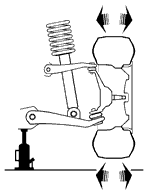Lower and upper ball joints can be tested for axial play by moving
the tire/wheel assembly or the upper control arm as indicated in Figure 1.
Both ball joints can be tested for radial play by moving the tire/wheel assembly
as indicated in Figure 2.
Typically the lower ball joint is unloaded when the vehicle is on a frame-contact lift,
or when a jack is placed under the cross-member. However, both joints can also be tested
using the procedures for TYPE 1 suspensions.

|

|
| Figure 1 | Figure 2 |